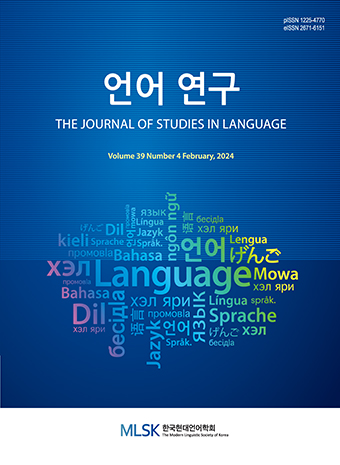Research Article
Abstract
References
Information
We cannot conceptualize time on its own terms. Conceptual metaphor theory shows how source domains including resource, space, entity, or even person are used to conceptualize time as a target domain. Since Lakoff and Johnson (1999), many linguists have focused on how space concepts are used to understand and express time. Evans (2004) developed a cognitive model for time, including the ‘moving time model’, ‘moving ego model’, and ‘temporal sequence model’. Later Evans (2013, 2019) adopted a unique characteristic of time, ‘transience’ and developed three temporal frames of references (t-FoRs) model: deitic t-FoR, sequential t-FoR, and extrinsic t-FoR.
- 吉本一. 2006. 시간 표현의 인지언어학적 연구. 부산대학교 박사학위 논문.
- 김기수. 2019. 실제 이동 경험이 시간에 대한 영어와 한국어 은유 표현의 이해에 미치는 영향. 『영어영문학 연구』 61, 229-248.
- 김진해. 2009. 개념적 은유의 상대성_19-20세기 초 고소설을 중심으로. 『어문연구』 37, 85-110.
- 백미현. 2014. 시간의 개념적 은유 모형: 자아중심적, 탈자아, 객관화된 자아 해석. 『언어연구』 29, 685-707. 10.18627/jslg.29.4.201403.685
- 임지룡. 2002. 시간의 개념화양상. 『어문학』 77, 201-222. 10.1016/S0025-6196(11)62339-2
- Alverson, H. 1994. Semantics and Experience: Universal Metaphors of Time in English, Mandarin, Hindi, and Sesotho. Baltimore, MD: The Johns Hopkins University Press.
- Bender, A. and S. Beller. 2014. Mapping spatial frames of reference onto time: A review of theoretical accounts and empirical findings. Cognition 132, 342-382. 10.1016/j.cognition.2014.03.016 24873738
- Boroditsky, L. 2000. Metaphoric structuring: understanding time through spatial metaphors. Cognition 75, 1-28. 10.1016/S0010-0277(99)00073-6
- Boroditsky, L. and M. Ramscar. 2002. The roles of body and mind in abstract thought. Psychological Science 13, 185-189. 10.1111/1467-9280.00434 11934006
- Evans, V. 2004. How We Conceptualize Time. Essays in Arts and Sciences 33, 13-44.
- Evans, V. 2006. Lexical concepts, cognitive models and meaning-construction. Cognitive Linguistics 17, 491-534. 10.1515/COG.2006.016
- Evans, V. 2013. Temporal frames of reference. Cognitive Linguistics 4, 393-435. 10.1515/cog-2013-0016
- Evans, V. 2019. Cognitive Linguistics: A Complete Guide. Edinburgh University Press.
- Galton, A. 2011. Time flies but space does not: Limits to the spatialisation of time. Journal of Pragmatics, 43, 695-703. 10.1016/j.pragma.2010.07.002
- Kövecses, Z. 2003. Cultural variation in metaphor. 『담화인지언어학회 학술대회 발표논문집』. 담화인지언어학회.
- Kövecses, Z. 2010. Metaphor: A Practical Introduction. 2nd edition. Oxford: Oxford University Press.
- Kranjec, A. 2006. Extending spatial frames of reference to temporal concepts. Proceedings of the Annual Meeting of the Cognitive Science Society, 28, 447-452, Retrieved from https://escholarship.org/us/item/7c57g5w1.
- Lakoff, G. 1993. The contemporary theory of metaphor. In A. Ortony (Ed.), Metaphor and Thought, 202-251. Cambridge: Cambridge University Press. 10.1017/CBO9781139173865.013
- Lakoff, G. and M. Johnson. 1980. Metaphor We Live By. Chicago and London: The University of Chicago Press.
- Lakoff, G. and M. Johnson. 1999. Philosophy in the Flesh: The Embodied Mind and Its Challenge to Western Thought. New York: Basic Books.
- Levinson, S. C. 2003. Space in Language and Cognition: Explorations in Cognitive Diversity. Cambridge: Cambridge University Press. 10.1017/CBO9780511613609
- Moore, K. E. 2006. Space to time mappings and temporal concepts. Cognitive Linguistics 17, 199-244. 10.1515/COG.2006.005
- Moore, K. E. 2011. Ego-perspective and field-based frames of reference: Temporal meanings of FRONT in Japanese, Wolof, and Aymara. Journal of Pragmatics 43, 759-776. 10.1016/j.pragma.2010.07.003
- Núñez, R., M. Benjamin and T. Ursina. 2006. Time After Time: The Psychological Reality of the Ego and Time-Reference-Point Distinction in Metaphorical Construals of Time. Metaphor and Symbol 21, 133-146. 10.1207/s15327868ms2103_1
- Núñez, R. and E. Sweetser. 2006. With the Future Behind Them: Convergent Evidence From Aymara Language and Gesture in the Crosslinguistic Comparison of Spatial Construals of Time. Cognitive Science 30, 401-450. 10.1207/s15516709cog0000_62 21702821
- Reddy, M. 1993. The Conduit Metaphor: A case of frame conflict in our language about language. In A. Ortony, ed., Metaphor and Thought (2nd ed.), 164-201. Cambridge: Cambridge University Press. 10.1017/CBO9781139173865.012
- Talmy, L. 2000. Toward a Cognitive Semantics. MIT Press, Cambridge, MA. 10.7551/mitpress/6847.001.0001
- Tenbrink, T. 2007. Space, Time, and the Use of Language. Berlin: Mouton de Gruyter. 10.1515/9783110198829 18726627
- Tenbrink, T. 2011. Reference frames of space and time in language. Journal of Pragmatics 43, 704-722. 10.1016/j.pragma.2010.06.020
- Yu, N. 1998. The Contemporary Theory of Metaphor: A Perspective from Chinese. Amsterdam: John Benjamins. 10.1075/hcp.1
- Zinken, J. 2010. Temporal frames of reference. In P. Chilton and V. Evans (Eds.), Language, Cognition, and Space: the state of the art and new directions, 479-498. London: Equinox Publishing.
- Publisher :The Modern Linguistic Society of Korea
- Publisher(Ko) :한국현대언어학회
- Journal Title :The Journal of Studies in Language
- Journal Title(Ko) :언어연구
- Volume : 37
- No :4
- Pages :445-461
- DOI :https://doi.org/10.18627/jslg.37.4.202202.445




 The Journal of Studies in Language
The Journal of Studies in Language






